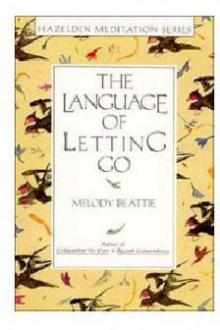More Language of Letting Go: 366 New Daily Meditations


Author: Melody Beattie
Category: Other3
Published: 2000
Series:
View: 264
Read OnlineThis new volume of meditations offers clients ongoing wisdom and guidance about relationship issues. An excellent enhancement to therapy, daily thoughts provide clients with ongoing insights into issues such as surrendering, the damaging effects of manipulation, and healthy communication. This book shares unsentimental, direct help for clients recovering from chemical dependency, healing from relationships and family issues, and exploring personal growth. About the AuthorBeattie was a struggling single parent of two children and freelance author and journalist cranking out stories for a small-town daily newspaper in 1986 when she came up with a book idea. She wanted to write a book about what happens to people when they love someone who is addicted to alcohol and other drugs."There were many books out there about how to help an addict or alcoholic. Nobody was talking about how an addict impacts the lives of the people around him or her, and how crazy you can become when you love someone who is addicted," Beattie said. "Even though I was sober, I didn't know how crazy I could get until it happened to me." Twenty publishers turned down Beattie's book proposal. "It's a good idea, but we don't think there's that many codependents out there," they wrote back.Hazelden, however, a treatment center and recovery publisher based in Minnesota, saw a need for the book. The publisher understood how families of alcoholics suffer and believed Beattie's book idea would help people. Beattie marched to the welfare department, asked for enough financial help to make it through the three months it would take her to write the book, then locked herself in a basement office and cranked out Codependent No More. Codependent No More has now sold 3.5 million copies. Beattie has since written nine more books, five for major publishing houses on the east and west coasts. She relocated from Minnesota to California, and she has long-since paid back the welfare department. Beattie has appeared in the pages of Newsweek and People and has been a regular guest on Geraldo and Oprah. Playing It By Heart is Beattie's first original book for Hazelden since 1990; the book is a return to her recovery roots that first brought her national recognition. Excerpt. © Reprinted by permission. All rights reserved.This is a book of essays, meditations, and activities—one for each day of the year. You can use it to begin your year on January 1. Or you can begin your year on your birthday, the day some people believe begins their personal new year. It's a companion book to the original Language of Letting Go (not a replacement or updated edition) and can be used by itself or in conjunction with that book. You can roll along with your life and use the book to address issues that arise. Or you can use this book as a workbook—or "playbook"—to address specific areas and issues you'd like to focus on in the upcoming year, such as releasing an outdated relationship or behavior, achieving cherished goals, or moving to the next level in work, in love, or in life.The essay that falls on the first day of each month explores the theme for the month. Each monthly topic is a major component in the process of letting go. You will also notice that skydiving, my new passion, has turned out to be a beautiful metaphor for the art of letting go and letting God do for us what we can't do for ourselves.I use God as the predominant word for references to God, Higher Power, Jehovah, or Allah. I may use He or She as the pronoun for God, depending on my mood. I mean no harm, nor is it my intention to discriminate or offend. Substitute whatever word pleases you to describe your idea of God.The prayers and ideas are meant as suggestions.May God bless you, your family, friends, and loved ones in this year to come. And may you guide yourself joyfully through the journey you choose, or have been called, to take.January 1 Trust that good will comeIt was a slow, boring January day at the Blue Sky Lodge. We had just moved in. The house was a mess. Construction hadn't begun yet. All we had was a plan, and a dream. It was too cold and rainy to skydive or even be outdoors. There wasn't any furniture yet. We were lying around on the floor.I don't know who got the idea first, him or me. But we both picked up Magic Markers about the same time. Then we started drawing on the wall."What do you want to happen in your life?" I asked. He drew pictures of seaplanes, and mountains, and boats leaving the shore. One picture was a video-camera man, jumping out of a plane. "I want adventure," he said.I drew pictures of a woman tromping around the world. She went to war-torn countries, then sat on a fence and watched. She visited the mountains and the oceans and many exciting places. Then I drew a heart around the entire picture, and she sat there in the middle of all the experiences on a big stack of books."I want stories," I said, "ones with a lot of heart."Across the entire picture, in big letters, he wrote the word "Woohoo."As an afterthought, I drew a woman sky diver who had just jumped out of the plane. She was frightened and grimacing. Next to her I wrote the words "Just relax."On the bottom of the wall I wrote, "The future is only limited by what we can see now." He grabbed a marker, crossed out "only," and changed it to "never.""There," he said, "it's done."Eventually, the house got cleaned up and the construction finished. Furniture arrived. And yellow paint covered the pictures on the wall. We didn't think much about that wall until months later. Sometimes slowly, sometimes quickly, and sometimes in ways we'd least expect, each of the pictures we'd drawn on that wall began to materialize and manifest."It's a magic wall," I said.Even if you can't imagine what's coming next, relax. The good pictures are still there. The wall will soon become covered with the story of your life. Thank God, the future is never limited by what we can see right now.The wall isn't magic.The magic is in us and what we believe.Before we start speaking the language of letting go, we need to understand what a powerful behavior letting go and letting God really is.God, help me do my part. Then help me let go, and let you do yours.*Activity: Meditate for a moment on the year ahead. Make a list of things you'd like to see happen, attributes you'd like to gain, things you'd like to get and do, changes you'd like to occur. You don't have to limit the list to this year. What do you want to happen in your life? Make a list of places you'd like to visit and things you'd like to see. Leave room for the unexpected, the unintended. But make room for the possibility of what you'd like, too—your intentions, wishes, dreams, hopes, and goals. Also, list what you're ready to let go of, too—things, people, attitudes, and behaviors you'd like to release. If anything were possible, anything at all, what are the possibilities you'd like to experience and see?January 2 Doing my partThe surest way to become Tense, Awkward, and Confused is to develop a mind that tries too hard—one that thinks too much.—Benjamin Hoff, The Tao of Pooh*The universe will help us, but we need to do our part as well. Here's an acronym, My Part, to help you remember what it means to do that.ManifestYourPowerAcceptRelaxTrustToo often, we tell ourselves the only way to get from point A to point B—or Z—is to tense up, obsess a little (or a lot), and live in fear and anxiety until what we want takes place.That isn't the path to success. It's the path to fear and anxiety.Accept. Relax. Breathe. Let go. Trust yourself, God, and the universe to manifest the best possible destiny when the time is right for you.God, help me make the journey from fear and control to letting go and stepping into my true power.January 3 Bring your ideals to lifeThere is a Zen story about two monks walking down a street after a heavy rain. Arriving at a corner, they came upon a beautiful girl in fine clothing unable to cross the muddy street without getting filthy."Here, I'll help you," said one monk. Lifting her in his arms, he carried her to the other side. The two monks walked in silence for a long time."We've sworn a vow of celibacy and are not supposed to go near women. It's dangerous," the second monk said to the first. "Why did you do that?""I left the girl back at the corner," the first monk said. "Are you still carrying her?"Sometimes, we may find ourselves in a situation where our ideals conflict. Being kind and loving to another person may conflict with our value of being committed and loving toward ourselves.When one ideal imposes on another, then use your judgment. Do the right thing by others. Do the right thing by yourself, too. Then let the incident pass and move on.For the monks in our story, right action usually meant not having contact with women. However, when encountering a stranded person on the road, right action became helping others. Ideals remain. Right thought, right action, right speech—but the path to those ideals may twist and turn throughout life. Be sensitive and aware that you are following an ideal and not a rigid belief.God, help me learn when it's time to let go.*Activity: In an earlier activity, we explored our goals and dreams list. Now, let's determine the ethics and ideals we want to live by, the code of conduct we want to follow. What's of foremost importance to you, whether or not your dreams come true and you achieve your goals? Examples of ideals may be staying clean and sober, honoring your commitments to others, and honoring your commitment to yourself. Many people choose additional spiritual values, such as compassion, honesty, tolerance. Some people choose to live by an ideal they call "Christ Consciousness," some "Buddha Consciousness," some the "Twelve Steps," and some the "Ten Commandments." List your ideals, and put that list with your goals. Let these ideals be a light that guides your path and allows you to live in harmony with others and yourself.©2008. All rights reserved. Reprinted from More Language of Letting Go by Melody Beattie. No part of this publication may be reproduced, stored in a retrieval system or transmitted in any form or by any means, without the written permission of the publisher. Publisher: Hazelden Publishing, PO Box 176 , Center City, MN 55012-0176.
 Ghost Heart
Ghost Heart 8 Hearts Beat As One: A Romance Anthology
8 Hearts Beat As One: A Romance Anthology 20-Inspector's Holiday
20-Inspector's Holiday The Long-Knives 6
The Long-Knives 6 The Wily Wastrel
The Wily Wastrel The King th-3
The King th-3 Dave the Unicorn: Dance Party
Dave the Unicorn: Dance Party A Lot Like Christmas
A Lot Like Christmas